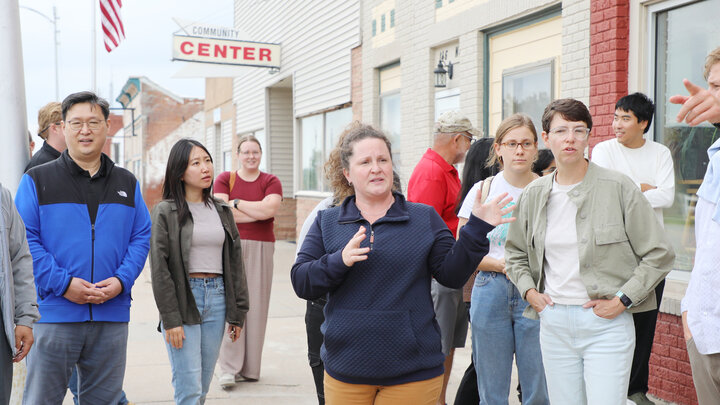Looking at different ways to make college course content relevant in a remote learning environment definitely presents challenges for faculty, especially for those disciplines heavily dependent on the traditional, design studio model where one-on-one instruction and feedback are core and sacred practices of the pedagogy. Instructors for the first-year, d.Make courses in the College of Architecture are looking at delivering instruction from a different perspective, mainly from above.
Using drone technology, instructors Nolan Golgert, Ernesto Sanchez Andrade, Matthew Miller and Salvador Lindquist teamed up with Craig Chandler, university communications director of photography, to capture location imagery for their students’ final design project set in the iconic alleyway between the Creamery building and The Burkholder Project Gallery of Lincoln’s Historic Haymarket.
Usually for built environment projects such as this, students conduct a comprehensive site inventory and analysis before design concepts or proposals begin. Data for this phase is typically done in-person, with students collecting observational information about the location in its entirety and how its surroundings impact the site. However, with UNL students learning remotely from all across Nebraska and beyond due to the COVID-19 pandemic, the instructors had to think creatively about how they would assist the students with this inventory and analysis phase.
The d.Make instructors reached out to Craig Chandler with ideas for capturing the necessary project imagery. Chandler, with guidance from the d.Make instructors, took videos and still imagery of the alleyway approach from both the north and south entrances; aerial, rooftop imagery of the entire project area; composite images of each building; and a video alley walk-through simulation to give students a complete understanding of the site in context.
“All of the d.Make instructors couldn’t be happier with how this collaboration turned out,” said Golgert. “Craig’s suggestions and ideas really opened up our eyes to new possibilities. The content he delivered was amazing, and I can’t wait to share it with the students and see the designs they eventually create for this project.”
As Golgert explains, utilizing Chandler’s drone content, students will work on a threshold development project that will encompass the vertical and horizontal landscape/field conditions connecting the site’s public and private spaces and their environment in a meaningful way.
“Being a former architecture student myself, I really enjoyed working on this collaboration with the d.Make instructors,” said Chandler. “In a time when our faculty are trying their best to figure out how to deliver instruction remotely, I was more than happy to pitch in and play my part in providing content that would enrich our students’ educational experience.”
“This collaboration is the true definition of synergy,” said Sanchez Andrade. “Craig Chandler’s imagery really helped elevate the content we deliver our students to the next level.”




